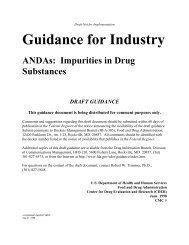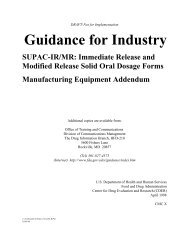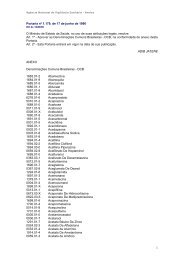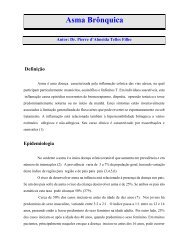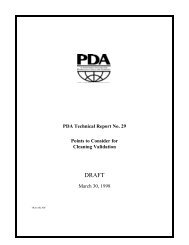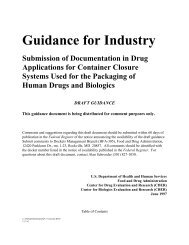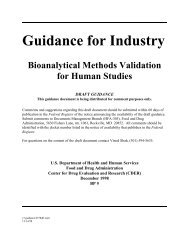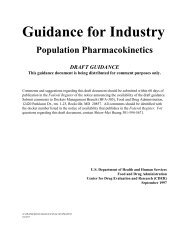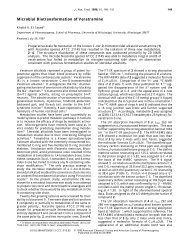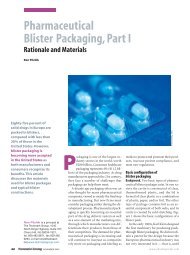Two New Isoflavones from Ceiba pentandra and Their ... - Pharmanet
Two New Isoflavones from Ceiba pentandra and Their ... - Pharmanet
Two New Isoflavones from Ceiba pentandra and Their ... - Pharmanet
Create successful ePaper yourself
Turn your PDF publications into a flip-book with our unique Google optimized e-Paper software.
8 J. Nat. Prod. 1998, 61, 8-12<br />
<strong>Two</strong> <strong>New</strong> <strong>Isoflavones</strong> <strong>from</strong> <strong>Ceiba</strong> <strong>pent<strong>and</strong>ra</strong> <strong>and</strong> <strong>Their</strong> Effect on<br />
Cyclooxygenase-Catalyzed Prostagl<strong>and</strong>in Biosynthesis<br />
Ylva Noreen, Hesham El-Seedi, Premila Perera, <strong>and</strong> Lars Bohlin*<br />
Division of Pharmacognosy, Department of Pharmacy, Biomedical Centre, Uppsala University, Box 579,<br />
S-751 23 Uppsala, Sweden<br />
Received April 8, 1997 X<br />
The new isoflavone glucoside vavain 3′-O-β-D-glucoside (1) <strong>and</strong> its aglycon, vavain (2), were<br />
isolated <strong>from</strong> the bark of <strong>Ceiba</strong> <strong>pent<strong>and</strong>ra</strong>, together with the known flavan-3-ol, (+)-catechin.<br />
These novel structures were elucidated by one- <strong>and</strong> two-dimensional NMR experiments <strong>and</strong><br />
by MS, IR, <strong>and</strong> UV spectroscopy as 5-hydroxy-7,4′,5′-trimethoxyisoflavone 3′-O-β-D-glucoside<br />
(1) <strong>and</strong> 5,3′-dihydroxy-7,4′,5′-trimethoxyisoflavone (2), respectively. The compounds were<br />
isolated following bioactivity-directed fractionation, using a cyclooxygenase-1-catalyzed prostagl<strong>and</strong>in<br />
biosynthesis assay in vitro, in which compounds 1 <strong>and</strong> 2 <strong>and</strong> (+)-catechin exhibited<br />
IC 50 values of 381, 97, <strong>and</strong> 80 µM, respectively (st<strong>and</strong>ard: indomethacin, IC 50 1.1 µM). When<br />
further tested for their inhibitory effects on cyclooxygenase-2-catalyzed prostagl<strong>and</strong>in biosynthesis,<br />
1 <strong>and</strong> 2 were found to be inactive (IC 50 > 1200 <strong>and</strong> >900 µM, respectively).<br />
<strong>Ceiba</strong> <strong>pent<strong>and</strong>ra</strong> (L.) Gaertner (Bombacaceae) is a<br />
tropical tree of economic importance due to the elastic<br />
<strong>and</strong> water resistant floss of the capsules commonly<br />
known as kapok, used in, e.g., cushions <strong>and</strong> lifejackets.<br />
1,2 This species is also widely used in traditional<br />
medicine. In Asia, Oceania, Africa, <strong>and</strong> Central America<br />
it is used for a variety of disorders including diarrhea,<br />
fever, gonorrhea, parasitic infections, <strong>and</strong> wounds <strong>and</strong><br />
as a diuretic <strong>and</strong> an emollient. 3 In the Samoan Isl<strong>and</strong>s,<br />
a cold water infusion of the bark of C. <strong>pent<strong>and</strong>ra</strong><br />
(vernacular name vavae) is used for asthma. 4 <strong>Two</strong><br />
studies have shown antiinflammatory properties of the<br />
bark extract, both in vitro <strong>and</strong> in vivo, 3,5 which can be<br />
related to several reports of traditional use in the<br />
treatment of ailments of an inflammatory nature such<br />
as asthma <strong>and</strong> cough. 3,6-8 In these studies, extracts<br />
showed suppression of carrageenan-induced rat paw<br />
edema as well as EPP-induced rat ear edema, 3 two in<br />
vivo experimental models of inflammation. Further, an<br />
extract was found to inhibit cyclooxygenase-1 (COX-1)-<br />
catalyzed prostagl<strong>and</strong>in biosynthesis in vitro. 3<br />
These results prompted us to further investigate the<br />
species phytochemically by bioactivity-directed fractionation<br />
using a prostagl<strong>and</strong>in biosynthesis assay in vitro.<br />
Previously reported constituents of this species include<br />
polysaccharides <strong>and</strong> xylans, 9,10 the naphthoquinone,<br />
7-hydroxycadelene, sesquiterpene lactones, 11 <strong>and</strong> fatty<br />
acids. 12-14 This paper deals with the isolation <strong>and</strong><br />
characterization of three flavonoids <strong>from</strong> the bark <strong>and</strong><br />
the assessment of their inhibitory properties on COX-1<br />
<strong>and</strong> cyclooxygenase-2 (COX-2)-derived prostagl<strong>and</strong>in<br />
biosynthesis.<br />
Results <strong>and</strong> Discussion<br />
Guided by an in vitro assay testing for inhibition of<br />
COX-1-catalyzed prostagl<strong>and</strong>in biosynthesis, a 70%<br />
* To whom correspondence should be addressed. Tel.: + 46 18<br />
4714492. Fax: + 46 18 509101. E-mail: lars.bohlin@pharmacog.uu.se.<br />
X<br />
Abstract published in Advance ACS Abstracts, December 1, 1997.<br />
aqueous ethanol extract of the bark of C. <strong>pent<strong>and</strong>ra</strong> was<br />
fractionated mainly by combining medium-pressure<br />
liquid chromatography (MPLC), high-speed countercurrent<br />
chromatography (HSCCC), <strong>and</strong> Sephadex LH-<br />
20 chromatographic techniques. The fractionation procedure<br />
resulted in the isolation of two new isoflavones,<br />
vavain 3′-O-β-D-glucoside (1) <strong>and</strong> vavain (2), along with<br />
the known flavan-3-ol, (+)-catechin. To our knowledge,<br />
isoflavonoids have so far not been reported before <strong>from</strong><br />
the genus <strong>Ceiba</strong>.<br />
The FABMS of 1 showed a peak at m/z 507 [M + H] + ,<br />
suggesting the molecular formula C 24 H 26 O 12 . The 1 H<br />
NMR spectrum exhibited a flavonoid pattern <strong>and</strong> showed<br />
a signal at δ 8.15 (1H, s), typical of the proton at C-2 of<br />
an isoflavonoid skeleton. 15,16 A singlet at δ 12.83, which<br />
disappeared on deuterium exchange, indicated a C-5<br />
hydroxyl. 17 This functionality was further confirmed by<br />
a bathochromic shift in the UV spectrum in the presence<br />
of AlCl 3 . 16,18,19 <strong>Two</strong> doublets at δ 6.96 <strong>and</strong> 6.93,<br />
integrating for one proton each, suggested a trioxygenated<br />
unsymmetrical B-ring. <strong>Two</strong> meta-coupled doublets<br />
at δ 6.54 <strong>and</strong> 6.38 (1H, J ) 2.0 Hz each) represented<br />
H-8 <strong>and</strong> H-6, respectively. 1<br />
H NMR resonances at δ 3.8<br />
to 3.4 <strong>and</strong> signals in the 13 C NMR spectrum just below<br />
δ 70 indicated the presence of a sugar moiety. A loss of<br />
162 mass units <strong>from</strong> the molecular ion in the FABMS<br />
<strong>and</strong> a signal at δ 61.71, shown by DEPT to represent a<br />
CH 2 group, suggested glucose or galactose. The carbohydrate<br />
moiety was confirmed as glucose by acid hydrolysis<br />
<strong>and</strong> subsequent TLC sugar analysis. The<br />
glucose 13 C NMR spectral data were in agreement with<br />
S0163-3864(97)00198-5 CCC: $15.00<br />
© 1998 American Chemical Society <strong>and</strong> American Society of Pharmacognosy<br />
Published on Web 01/23/1998
Inhibitory <strong>Isoflavones</strong> <strong>from</strong> <strong>Ceiba</strong> Journal of Natural Products, 1998, Vol. 61, No. 1 9<br />
Table 1. 1<br />
H-NMR Spectral Data of Compounds 1 <strong>and</strong> 2<br />
proton<br />
(AcCN-d 3 + D 2O)<br />
20 °C (AcCN-d 3)60°C<br />
1<br />
H δ (integral,<br />
mult, J (Hz))<br />
compound<br />
1 2<br />
1<br />
H δ (integral,<br />
mult, J (Hz))<br />
long-range<br />
COSY<br />
(AcCN-d 3 + D 2O)<br />
20 °C (AcCN-d 3)60°C<br />
1<br />
H δ (integral,<br />
mult, J (Hz))<br />
1<br />
H δ (integral,<br />
mult, J (Hz))<br />
long-range<br />
COSY<br />
H-2 8.15 (1H, s) 8.12 (1H, s) 8.10 (1H, s) 8.07 (1H, s)<br />
H-6 6.38 (1H, d, 2.0) 6.40 (1H, d, 2.3) H-8, 7-OMe 6.39 (1H, d, 2.3) 6.39 (1H, d, 2.2) H-8, 7-OMe<br />
H-8 6.54 (1H, d, 2.0) 6.54 (1H, d, 2.3) H-6, 7-OMe 6.55 (1H, d, 2.3) 6.53 (1H, d, 2.3) H-6, 7-OMe<br />
H2′ 6.96 (1H, d) 7.07 (1H, d, 2.0) H-6′, H-1′′ 6.71 (1H, d, 2.0) 6.75 (1H, d, 1.9)<br />
H-6′ 6.93 (1H, d) 6.97 (1H, d, 2.0) H-2′, 5′-OMe 6.73 (1H, d, 2.0) 6.76 (1H, d, 2.0) 5′-OMe<br />
H-1′′ 4.99 (1H, d, 7.3) 4.94 (1H, d, 7.3) H-2′, H-2′′-H-5′′<br />
H-2′′-H-5′′ 3.46-3.57 (4H, m) 3.36-3.55 (4H, m) H-1′′, H-2′′-H-5′′<br />
H-6 A′′ 3.80 (1H, dd) 3.81 (1H, dd, 2.5, 2.7, 11.9) H-2′′-H-5′′<br />
H-6 B′′ 3.67 (1H, dd, 2.6, 3.6, 12.7) 3.66 (1H, dd, 5.3, 5.5, 11.8) H-2′′-H-5′′<br />
OMe 3.86 (6H, s); 3.83 (3H, s) pos. 7: 3.90 (3H, s) H-6, H-8 3.88 (3H, s); pos. 7: 3.90 (3H, s) H-6, H-8<br />
OMe pos. 4′: 3.86 (3H, s) 3.85 (3H, s); pos. 4′: 3.87 (3H, s)<br />
OMe pos. 5′: 3.88 (3H, s) H-6′ 3.82 (3H, s) pos. 5′: 3.88 (3H, s) H-6′<br />
Table 2. 13 C-NMR Spectral Data of Compounds 1 <strong>and</strong> 2<br />
compound<br />
1 2<br />
(AcCN-d 3 + D 2O) 20 °C (AcCN-d 3) 60 °C (AcCN-d 3)60°C<br />
carbon 13 C DEPT C-H COSY (δ 1 H) 13 C HMBC HMQC 13 C HMBC HMQC<br />
2 155.90 CH 8.15 155.88 155.98 H-2′ H-2<br />
3 123.75 C 124.45 H-2, H-2′, H-6′ 125.02 H-2, H-2′, H-6′<br />
4 181.60 C 182.16 H-2 182.56 H-2<br />
5 162.62 C 164.06 H-6 164.41 H-6<br />
6 99.30 CH 6.38 99.67 H-8 H-6 99.89 H-8 H-6<br />
7 166.74 C 167.47 167.71 H-6, H-8<br />
8 93.58 CH 6.54 93.89 H-8 94.11 H-6 H-8<br />
9 158.92 C 159.52 H-2, H-8 159.84 H-2, H-8<br />
10 106.74 C 107.50 H-6, H-8 107.82 H-6, H-8<br />
1′ 127.89 C 127.91 128.53 H-2<br />
2′ 111.01 CH 6.96 113.10 H-6′ H-2′ 111.29 H-6′ H-2′<br />
3′ 151.26 C 152.02 151.52 H-2′<br />
4′ 139.12 C 141.19 H-2′, H-6′ 138.30 H-2′, H-6′<br />
5′ 154.01 C 154.94 154.66 H-6′<br />
6′ 109.00 CH 6.93 110.21 H-2′ H-6′ 107.58 H-2′ H-6′<br />
1′′ 101.81 CH 4.99 103.15 H-1′′<br />
2′′ 74.05 CH 3.4-3.6 75.22 H-2′′, H-3′′,<br />
3′′ 76.85 a CH 3.4-3.6 78.19 a H-4′′, H-5′′<br />
4′′ 70.30 CH 3.4-3.6 71.98<br />
5′′ 77.28 a CH 3.4-3.6 78.31 a<br />
6′′ 61.71 CH 2 3.8 63.31 H-6′′<br />
OMe 56.93 CH 3 3.85 57.58 MeO-7 57.55 MeO-7<br />
OMe 61.87 CH 3 61.89 MeO-4′ 61.93 MeO-4′<br />
OMe 56.93 CH 3 3.85 57.27 MeO-5′ 57.63 MeO-5′<br />
a<br />
Assignments with the same superscript letter may be interchanged.<br />
Figure 1. HMBC connectivities of 1.<br />
the literature. 20-22 The anomeric glucose proton appeared<br />
at δ 4.99 as a doublet with a coupling constant<br />
of J ) 7.3 Hz, indicating a β-linkage of the glucose unit<br />
to the aglycon. 16 Signals attributed to three methoxy<br />
groups were observed at δ 3.83 (3H, s) <strong>and</strong> δ 3.86 (6H,<br />
s). The above data in conjunction with the 13 C NMR<br />
spectrum (DEPT sequence) were found to be consistent<br />
with an isoflavone glucoside structure. Assignments of<br />
the protonated carbons were made using C-H COSY<br />
(HETCOR). The results are shown in Tables 1 <strong>and</strong> 2.<br />
In the 13 C NMR spectrum of 1 one methoxyl group<br />
was found at δ 61.87, <strong>and</strong> there were another two at δ<br />
56.93. The shift of the former below δ 60 indicated its<br />
placement between two oxygenated carbons 23 <strong>and</strong> suggested<br />
the following configuration of the B-ring: the<br />
glucose unit occurred at position C-3′ <strong>and</strong> two methoxyl<br />
groups were affixed to positions C-4′ <strong>and</strong> C-5′. 17 To<br />
confirm this, HMBC <strong>and</strong> long-range COSY experiments<br />
were performed (Figure 1). Because of viscosity problems<br />
(the compound had tendencies to form a gel in<br />
solution), these spectra were recorded at an elevated<br />
temperature (60 °C).<br />
1 H <strong>and</strong> 13 C NMR spectra were<br />
rerun at this temperature. From long-range COSY<br />
connectivities (Figure 3) the proposed configuration of<br />
the B-ring was confirmed, since cross-peaks <strong>from</strong> H-2′<br />
to H-1′′ were found, as well as <strong>from</strong> H-6′ to OMe.<br />
Furthermore, connectivities <strong>from</strong> both H-6 <strong>and</strong> H-8 to<br />
OMe were observed, which placed the third methoxyl<br />
group at position C-7. The structure of 1 was thus
10 Journal of Natural Products, 1998, Vol. 61, No. 1 Noreen et al.<br />
Figure 2. HMBC connectivities of 2.<br />
Figure 3. Important long-range COSY connectivities observed<br />
for 1.<br />
many antiinflammatory drugs, although the effects<br />
observed in vitro may not have an in vivo counterpart.<br />
24-26 With the COX-1-catalyzed prostagl<strong>and</strong>in<br />
biosynthesis assay in vitro, as employed in the bioactivity-directed<br />
fractionation, vavain 3′-O-β-D-glucoside<br />
(1), vavain (2), <strong>and</strong> (+)-catechin exhibited IC 50 values<br />
of 381, 97, <strong>and</strong> 80 µM, respectively. The values can be<br />
compared with indomethacin (IC 50 of 1.1 µM), one of the<br />
strongest inhibitors of prostagl<strong>and</strong>in biosynthesis 27 <strong>and</strong><br />
acetylsalicylic acid (aspirin), a much weaker inhibitor<br />
in this test system, exhibiting an IC 50 value of 1 mM.<br />
Compounds 1, 2, <strong>and</strong> (+)-catechin were further tested<br />
for their inhibitory activities on COX-2-catalyzed prostagl<strong>and</strong>in<br />
biosynthesis, with 1 <strong>and</strong> 2 found to be<br />
essentially inactive. The IC 50 value for 1 was over 1.2<br />
mM <strong>and</strong> that for 2 over 900 µM (maximum dissoluble<br />
concentration of 2 in solvents available to the assay).<br />
The isoflavones 1 <strong>and</strong> 2 thus exhibited a certain COX-1<br />
selectivity. Further studies of the inhibitory activities<br />
on the COX-1- <strong>and</strong> COX-2-catalyzed prostagl<strong>and</strong>in<br />
biosynthesis by (+)-catechin are described in the accompanying<br />
paper. 28<br />
It cannot be ruled out that the aglycon, vavain (2), is<br />
an artifact of the glucoside, 1, <strong>and</strong> thus formed by<br />
hydrolysis during extraction. Simultaneous occurrence<br />
of isoflavonoid aglycons <strong>and</strong> their O-glycosides have,<br />
however, been reported previously <strong>from</strong> several plant<br />
species. 29-31 Vavain 3′-O-β-D-glucoside (1) did not decompose<br />
under any of the laboratory conditions applied.<br />
Figure 4. Long-range COSY connectivities for 2.<br />
established as 5-hydroxy-7,4′,5′-trimethoxyisoflavone 3′-<br />
O-β-D-glucoside (vavain 3′-O-β-D-glucoside).<br />
The 1 H NMR <strong>and</strong> 13 C NMR data of 2 were similar to<br />
1 apart <strong>from</strong> the absence of sugar resonances <strong>and</strong> the<br />
fact that three separate methoxy signals could be<br />
observed in the 1 H NMR spectrum when run at 20 °C<br />
[δ 3.81 (3H, s), 3.85 (3H, s), 3.88 (3H, s)]. The 1 H NMR<br />
spectrum exhibited the same indication of a C-5 hydroxyl,<br />
which was confirmed by UV data with AlCl 3 shift<br />
reagent, as performed for 1. The EIMS <strong>and</strong> FABMS of<br />
2 showed peaks at m/z 344 <strong>and</strong> 345 [M + H] + , respectively,<br />
suggesting the molecular formula C 18 H 16 O 7 . The<br />
presence of a [M - 15] + ion in the MS indicated the loss<br />
of a methyl group. Ions at m/z 315 <strong>and</strong> 301 indicated<br />
two other methyl groups. An ion at m/z 167 was<br />
assigned to a retro-Diels-Alder fragmentation product.<br />
Ring A was thus substituted with one methoxyl <strong>and</strong> one<br />
hydroxy group. The long-range COSY spectrum (Figure<br />
4) in conjunction with the HMQC spectrum allowed the<br />
assignment of the individual methoxyl units to positions<br />
C-4′, C-5′, <strong>and</strong> C-7, respectively (Tables 1 <strong>and</strong> 2). The<br />
HMBC spectrum (Figure 2) confirmed the structure.<br />
Thus, 2 was assigned as 5,3′-dihydroxy-7,4′,5′-trimethoxyisoflavone,<br />
which has been given the trivial name<br />
vavain.<br />
The antiinflammatory effect of the isolated compounds<br />
was assessed employing an in vitro assay testing<br />
for inhibition of COX-catalyzed prostagl<strong>and</strong>in biosynthesis.<br />
Prostagl<strong>and</strong>ins are important mediators in the<br />
inflammatory process, <strong>and</strong> the inhibition of COX is<br />
considered to be involved in the mechanism of action of<br />
Experimental Section<br />
General Experimental Procedures. EIMS, HR-<br />
FABMS, <strong>and</strong> positive-ion FABMS (with glycerol as<br />
matrix) spectra were recorded with a JEOL JMS SX/<br />
SX102A instrument.<br />
1 H <strong>and</strong> 13 C NMR, DEPT, <strong>and</strong> C-H COSY (HETCOR)<br />
<strong>and</strong> further spectra were obtained in acetonitrile-d 3 +<br />
D 2 O(5-10%) at 20 °C with TMS as internal st<strong>and</strong>ard<br />
using a 270 MHz JEOL JNM Ex-270/4000 NMR instrument.<br />
1 H <strong>and</strong> 13 C NMR, inverse heteronuclear correlations<br />
HMBC <strong>and</strong> HMQC, as well as long-range COSY<br />
spectra were recorded at 60 °C in acetonitrile-d 3 on a<br />
400 MHz Varian VXR-400 NMR instrument, IR spectra<br />
were recorded with a Nicolet MX-S spectrophotometer,<br />
<strong>and</strong> UV spectra were recorded with a Perkin-Elmer<br />
Lambda 2 UV/vis spectrophotometer. Melting points<br />
are uncorrected <strong>and</strong> were determined using a Digital<br />
melting point apparatus (Model IA 8103, Electrothermal<br />
Engineering Ltd, Southend-on-Sea, Essex, U.K.). The<br />
optical rotation was determined in Me 2 CO or EtOH at<br />
ambient temperature using a Perkin-Elmer Model 241<br />
polarimeter.<br />
TLC was performed on precoated aluminum sheets<br />
[silica 60 F 254 , 0.25 mm (Merck, Darmstadt, Germany)]<br />
<strong>and</strong> preparative TLC on precoated glass sheets [silica<br />
60 F 254 , 0.5 mm (Merck)], with detection provided by<br />
UV light (254 <strong>and</strong> 366 nm) <strong>and</strong> by spraying with<br />
vanillin-sulfuric acid reagent followed by heating (120<br />
°C).<br />
A three-phase liquid extraction procedure has been<br />
described by Nyiredy et al. 32 <strong>and</strong> was carried out in this<br />
investigation using a separatory funnel, partitioning the<br />
plant extract, <strong>and</strong> retrieving each phase separately.
Inhibitory <strong>Isoflavones</strong> <strong>from</strong> <strong>Ceiba</strong> Journal of Natural Products, 1998, Vol. 61, No. 1 11<br />
MPLC was performed with SEPARO MPLC equipment<br />
(Bæckström Separo AB, Lidingö, Sweden). 33 SEPARO<br />
variable-length glass columns with an inner diameter<br />
of 1.5 or 2.5 cm, packed with silica gel 60, 40-63 µm<br />
(Merck), were used. An FMI Lab pump, Model QD<br />
(Fluid Metering, Inc., Oyster Bay, NY) was used at a<br />
flow of 20-30 mL/min. Fractions of 9 mL were collected<br />
with a Gilson Model 201 fraction collector. Columns<br />
were eluted with continuous gradients running <strong>from</strong><br />
hexane, over CH 2 Cl 2 to MeOH, <strong>and</strong> H 2 O afforded by a<br />
SEPARO constant-volume mixing chamber combined<br />
with an open reservoir. Initially, the mixing chamber<br />
contained 50 mL of nonpolar solvent <strong>and</strong> the reservoir<br />
the first of 15-20 premixed binary (less polar/more<br />
polar solvent) gradient mixtures, of 20-40 mL each,<br />
which were successively fed to the reservoir during<br />
separation. High-speed counter-current chromatography<br />
(HSCCC) was carried out using an Ito Multi-Layer<br />
Coil CCC instrument (PC Inc., Potomac, MD). Coil #10<br />
with a volume of 370 mL was used at 800 rpm. The<br />
flow was 3 mL/min provided by an LKB 2150 HPLC<br />
pump (LKB, Bromma, Sweden). Fractions collected<br />
ranged <strong>from</strong> 9 to 15 mL. Column chromatography was<br />
performed over Sephadex LH-20 (Pharmacia, Uppsala,<br />
Sweden).<br />
During bioactivity-directed fractionation, extracts <strong>and</strong><br />
crude <strong>and</strong> semi-purified fractions, dissolved in 10%<br />
EtOH or 0.5-20% DMSO to a final concentration of 100<br />
µg/mL, were tested for inhibitory effects in a COX-1-<br />
catalyzed prostagl<strong>and</strong>in biosynthesis assay in vitro. 34<br />
For IC 50 value determinations compound 1 <strong>and</strong> (+)-<br />
catechin were dissolved in 10% aqueous EtOH, while 2<br />
was dissolved in 20% DMSO (yielding final concentrations<br />
of 2% <strong>and</strong> 4% of the respective solvent under the<br />
assay conditions). Materials for COX-1 <strong>and</strong> COX-2<br />
prostagl<strong>and</strong>in biosynthesis assay were as follows: [ 14 C]-<br />
arachidonic acid (Amersham), l-epinephrine (Apoteksbolaget,<br />
Stockholm, Sweden), arachidonic acid, aspirin<br />
(acetylsalicylic acid), indomethacin, prostagl<strong>and</strong>ins E 2<br />
<strong>and</strong> F 2R , <strong>and</strong> reduced glutathione (Sigma). For chromatographic<br />
separation, silica gel 60, 63-200 µm<br />
(Merck) was used. Chemicals <strong>and</strong> solvents were of<br />
analytical grade.<br />
Plant Material. C. <strong>pent<strong>and</strong>ra</strong> (L.) Gaertner bark<br />
was collected at the isl<strong>and</strong> of Savai’i of Western Samoa<br />
in November 1991 <strong>and</strong> authenticated by Prof. Paul A.<br />
Cox, Department of Botany <strong>and</strong> Range Science, Brigham<br />
Young University, Provo, UT. A voucher specimen (SA<br />
8) is deposited at the Division of Pharmacognosy,<br />
Department of Pharmacy, Uppsala University, Sweden.<br />
Extraction <strong>and</strong> Isolation. Powdered bark of C.<br />
<strong>pent<strong>and</strong>ra</strong> (1.25 kg) was extracted three times in aqueous<br />
70% EtOH (1 kg of material dry weight to 10 L of<br />
aqueous EtOH first extraction, 1:5 second <strong>and</strong> third<br />
extractions) at room temperature overnight with occasional<br />
stirring. The dried crude extract (68.8 g) was<br />
subjected to a three-phase liquid extraction procedure<br />
with a solvent system consisting of n-hexane-CH 2 Cl 2 -<br />
AcCN-H 2 O (26:13:44:13) (910 mL/455 mL/1540 mL/455<br />
mL × 2) yielding three extracts: hexane (2.3 g), AcCN/<br />
CH 2 Cl 2 (3.9 g), <strong>and</strong> H 2 O. The H 2 O extract was further<br />
extracted with EtOAc (120 × 3 mL), thus yielding an<br />
EtOAc extract (4.5 g) <strong>and</strong> an H 2 O extract (46.9 g).<br />
A portion of the EtOAc extract (1.5 g) was adsorbed<br />
onto silica gel <strong>and</strong> chromatographed on a SEPARO<br />
column eluted with a continuous gradient <strong>from</strong> hexane<br />
over CH 2 Cl 2 to MeOH of increasing polarity. Eluted<br />
fractions were evaluated by TLC <strong>and</strong> combined upon<br />
similar appearance, yielding 13 fractions. Fraction 8<br />
(170 mg) was combined with several fractions (ca. 70<br />
mg) exhibiting similar TLC profiles <strong>from</strong> two earlier<br />
HSCCC separations of portions of the EtOAc extract;<br />
the solvent system used in both cases was n-hexane-<br />
EtOAc-MeOH-H 2 O (1:8:4:10) [first separation, EtOAc<br />
extract (500 mg), aqueous phase was used as mobile<br />
phase, retention of stationary phase was 32%; second<br />
separation, EtOAc extract (400 mg), organic phase as<br />
mobile phase, 62% retention of stationary phase]. The<br />
combined fractions (240 mg) were subjected to a third<br />
HSCCC separation [CHCl 3 -MeOH-1-BuOH-H 2 O (10:<br />
10:1:6), organic phase as mobile phase, 70% retention<br />
of stationary phase] <strong>from</strong> which 10 fractions were<br />
obtained. Fraction 2 contained (+)-catechin, which was<br />
further purified over Sephadex LH-20, eluted by MeOH-<br />
1-PrOH (1:1), yielding 19 mg. Fraction 10 (the contents<br />
remaining in the stationary phase after completion of<br />
the separation) was purified over Sephadex LH-20 (1-<br />
PrOH), which afforded vavain 3′-O-β-D-glucoside (1, 36<br />
mg).<br />
The AcCN/CH 2 Cl 2 extract was separated by MPLC,<br />
with a continuous gradient <strong>from</strong> n-hexane to CH 2 Cl 2<br />
over MeOH to H 2 O, which afforded 20 fractions. Fraction<br />
11 (180 mg) was chromatographed over Sephadex<br />
LH-20 eluted with 1-PrOH <strong>and</strong> further separated by<br />
preparative TLC (CH 2 Cl 2 -MeOH, 9:1), which yielded<br />
4 mg of vavain (2). Fraction 12 (300 mg) was rechromatographed<br />
on a SEPARO column with the same<br />
continuous gradient as employed previously, followed<br />
by chromatography over Sephadex LH-20 with 1-PrOH<br />
as eluent, which yielded 3.7 mg of 2.<br />
Acid Hydrolysis of 1. Compound 1 (24 mg) was<br />
refluxed for 75 min with 4 N HCl in MeOH (35 mL).<br />
The acid hydrolysate was concentrated, extracted with<br />
EtOAc, <strong>and</strong> examined by TLC on silica gel in CHCl 3 <strong>and</strong><br />
1 H NMR for the liberated aglycon, which was identified<br />
by direct comparison ( 1 H NMR, TLC) with the isolated<br />
naturally occurring 2. The acidic mother liquor was<br />
neutralized with Na 2 CO 3 , filtered, <strong>and</strong> evaporated to<br />
dryness for examination of the sugar moiety, which<br />
proved to be glucose by detection on TLC [EtOAcisopropanol-H<br />
2 O (65:23:12)], <strong>and</strong> sprayed with freshly<br />
prepared anisaldehyde-H 2 SO 4 reagent followed by<br />
heating. 35<br />
5-Hydroxy-7,4′,5′-trimethoxyisoflavone 3′-O-β-Dglucoside<br />
(vavain 3′-O-β-D-glucoside) (1) was crystallized<br />
<strong>from</strong> EtOH as light yellow crystals: mp 140-<br />
141 °C; [R] 20 D -8.0° (c 0.1, EtOH); UV (MeOH) λ max (log<br />
ɛ) 261 (+AlCl 3 ) 270 nm; IR (KBr) v max 3390 (OH), 2931-<br />
2852 (CH, aliphatic), 1660 (CdO), 1618, 1585, 1571,<br />
1512, 1447, 1349, 1305, 1249, 1212, 1200, 1170, 1155,<br />
1104, 1077, 1054, 993, 831; 1 H <strong>and</strong> 13 C NMR data, see<br />
Tables 1 <strong>and</strong> 2, respectively; HR-positive FABMS m/z<br />
[M + Na] + 529.1529 (C 24 H 26 O 12 Na requires 529.1322);<br />
FABMS m/z 507 [M + H] + , 491, 437, 373, 345 ([M + H]<br />
- 162) + , 315, 285, 257, 193, 167, 151.<br />
5,3′-Dihydroxy-7,4′,5′-trimethoxyisoflavone<br />
(vavain) (2) was crystallized <strong>from</strong> AcCN-CH 2 Cl 2 as a
12 Journal of Natural Products, 1998, Vol. 61, No. 1 Noreen et al.<br />
white amorphous solid: mp 169-170 °C; UV (MeOH)<br />
λ max (log ɛ) 260 (+AlCl 3 ) 270 nm; IR (KBr) v max 3423<br />
(OH), 2966-2854 (CH, aliphatic), 1665 (CdO), 1624,<br />
1588, 1511, 1447, 1377, 1357, 1293, 1202, 1167, 1061,<br />
998, 829 cm -1 ; 1 H <strong>and</strong> 13 C NMR data, see Tables 1 <strong>and</strong><br />
2, respectively; HR-positive FABMS m/z [M + H] +<br />
345.0979 (C 18 H 17 O 7 requires 345.0974); EIMS (70 eV)<br />
m/z 344 [M + ] (100), 329 (46), 315 (4), 301 (24), 297 (7),<br />
269 (5), 257 (4), 230 (13), 192 (2), 167 (17), 142 (8), 135<br />
(7), 115 (5); FABMS m/z 345 [M + H] + , 331, 299, 275,<br />
245, 215, 207, 183, 167, 115.<br />
(+)-Catechin was crystallized <strong>from</strong> AcCN-CH 2 Cl 2<br />
(2:1) (19 mg) <strong>and</strong> identified by comparison of its 1 H <strong>and</strong><br />
13 C NMR (MeOH-d 4 ) spectra with literature data, 36<br />
[R] 20 D +5.9° (c 0.1, Me 2 CO).<br />
COX-1 <strong>and</strong> COX-2-Catalyzed Prostagl<strong>and</strong>in Biosynthesis<br />
Assay. The assay followed the method<br />
developed by White <strong>and</strong> Glassman. 34 Bovine cyclooxygenase-1<br />
(prostagl<strong>and</strong>in endoperoxide H synthase-1)<br />
was derived as described by Takeguchi et al. 37 COX-2<br />
(prostagl<strong>and</strong>in endoperoxide H synthase-2) enzyme<br />
purified <strong>from</strong> sheep placental cotyledons was procured<br />
<strong>from</strong> Cayman Chemical Company, Ann Arbor, MI.<br />
Bovine seminal vesicle microsomes (10 µL, 20-30 µg<br />
protein) or purified sheep placental COX-2 enzyme (10<br />
µL, 5 units, 0.8 µg) were preincubated with 50 µL of<br />
cofactor solution (reduced glutathione <strong>and</strong> l-epinephrine,<br />
0.3 mg/mL each in Tris buffer, pH 8.2) in an ice-water<br />
bath for 15 min. Vehicle or test solution (20 µL) <strong>and</strong><br />
20 µL of[ 14 C]arachidonic acid (16 Ci/mol, 30 µM) were<br />
added <strong>and</strong> incubated at 37 °C for 10 min. A blank was<br />
kept in the ice-water bath. After incubation, the<br />
reaction was terminated by adding 10 µL of2NHCl<br />
followed by 5 µL of a carrier solution (PGE 2 <strong>and</strong> PGF 2R<br />
0.2 mg/mL of each in EtOH). The unmetabolized<br />
arachidonic acid was separated <strong>from</strong> the prostagl<strong>and</strong>in<br />
products by column chromatography <strong>and</strong> eluted with<br />
n-hexane-dioxane-glacial acetic acid (70:30:1). The<br />
prostagl<strong>and</strong>in products were then eluted with EtAOc-<br />
MeOH (85:15), <strong>and</strong> the samples were counted in a<br />
Packard scintillation spectrometer. Indomethacin (2 µg/<br />
mL) was used as a positive control, yielding 70-90%<br />
inhibition. IC 50 values were determined by regression<br />
analysis.<br />
Acknowledgment. We are grateful to Rolf Andersson<br />
for recording NMR spectra, Suresh Gohil for MS<br />
measurements, <strong>and</strong> Jan Straube <strong>and</strong> Kerstin Ekehov-<br />
Karlsson for skillful technical assistance. We also thank<br />
Prof. Paul A. Cox for plant collection <strong>and</strong> authentication.<br />
The Swedish Council for Forestry <strong>and</strong> Agricultural<br />
Science is gratefully acknowledged for financial support<br />
<strong>and</strong> the Swedish Institute for providing a scholarship<br />
for H.E.<br />
References <strong>and</strong> Notes<br />
(1) Baker, H. G. In Ecology <strong>and</strong> Economic Development in Tropical<br />
Africa; Brokensha, D., Ed.; Institute of International Studies,<br />
Research Series; University of California: Berkeley, CA, 1965;<br />
pp 185-216.<br />
(2) Smith, A. C.; Darwin, S. P. Flora Vitiensis Nova. A <strong>New</strong> Flora<br />
of Fiji (Spermatophytes only); Pacific Tropical Botanical Garden:<br />
Lawai, Kauai, 1979-1988; Vol. II, pp 411-414.<br />
(3) Andersson-Dunstan, C.; Noreen, Y.; Serrano, G.; Cox, P. A.;<br />
Perera, P.; Bohlin, L. J. Ethnopharmacol. 1997, 57, 35-56.<br />
(4) Cox, P. A. J. Ethnopharmacol. 1993, 38, 181-188.<br />
(5) Lin, C.-c.; Chen, S.-y.; Lin, J.-m.; Chiu, H.-f. Am. J. Chin. Med.<br />
1992, 20, 135-146.<br />
(6) Heyne, K. De Nuttige Planten van Indonesië (Reprint of De<br />
Nuttige Planten van Nederl<strong>and</strong>sch-Indië, 2nd ed.; 1927. Djakarta);<br />
Veeman und Zonen: Wageningen, The Netherl<strong>and</strong>s, 1950;<br />
Vols. I <strong>and</strong> II, pp 1050-1055.<br />
(7) Quisumbing, E. Technical Bulletin (Republic of Philippines<br />
Department of Agriculture <strong>and</strong> Natural Resources) 1951, No. 16,<br />
pp 501-505.<br />
(8) Burkill, I. H.; Haniff, M. Gardens’ Bull. (Straits Settlement) 1930,<br />
6, 174.<br />
(9) Raju, T. S.; Gowda, D. C.; Anjaneyalu, Y. V. Carbohydr. Res.<br />
1989, 191, 321-332.<br />
(10) Raju, T. S.; Gowda, D. C.; Anjaneyalu, Y. V. Carbohydr. Res.<br />
1989, 191, 333-341.<br />
(11) Rao, K. V.; Sreeramulu, K.; Gunasekar, D.; Ramesh, D. J. Nat.<br />
Prod. 1993, 56, 2041-2045.<br />
(12) Berry, S. K. J. Food Sci. Technol. 1980, 17, 224-227.<br />
(13) Kaimal, T. N. B.; Lakshminarayana, G. Phytochemistry 1970,<br />
9, 2225-2229.<br />
(14) Kaimal, T. N. B.; Lakshminarayana, G. Phytochemistry 1972,<br />
11, 1617-1622.<br />
(15) Sethi, M. L.; Taneja, S. C.; Agarwal, S. G.; Dhar, K. L.; Atal, C.<br />
C. Phytochemistry 1980, 19, 1831-1832.<br />
(16) Mabry, T. J.; Markham, K. R.; Thomas, M. B. The Systematic<br />
Identification of Flavonoids; Springer: Berlin, 1970.<br />
(17) Ali, A. A.; El-Emary, N. A.; El-Moghazi, M. A.; Darwish, F. M.;<br />
Frahm, A. W. Phytochemistry 1983, 22, 2061-2063.<br />
(18) Voirin, B. Phytochemistry 1983, 22, 2107-2145.<br />
(19) Tahara, S.; Moriyama, M.; Ingham, J.; Mizutani, J. Phytochemistry<br />
1991, 30, 2769-2775.<br />
(20) Merfort, I.; Wendisch, D. Planta Med. 1987, 53, 434-437.<br />
(21) Agarwal, P. K. Phytochemistry 1992, 31, 3307-3330.<br />
(22) Bock, K.; Pedersen, C. Adv. Carbohydr. Chem. Biochem. 1983,<br />
41, 27-66.<br />
(23) Sree Rama Murthy, M.; Venkata Rao, E.; Ward, R. S. Magn.<br />
Reson. Chem. 1986, 24, 225-230.<br />
(24) Gryglewski, R. J. In Advances in Lipid Research; Paoletti, R.,<br />
Kritchevsky, D., Eds.; Academic Press: Inc.: <strong>New</strong> York, 1978;<br />
Vol. 16, pp 327-343.<br />
(25) Wagner, H. Planta Med. 1989, 55, 235-241.<br />
(26) Mukherjee, A.; Hale, V. G.; Borga, O.; Stein, R. Inflammation<br />
Res. 1996, 45, 531-540.<br />
(27) Redl, K.; Breu, W.; Davis, B.; Bauer, R. Planta Med. 1994, 60,<br />
58-62.<br />
(28) Noreen, Y.; Ringbom, T.; Perera, P.; Bohlin, L. J. Nat. Prod.<br />
1997, 60, 2-7.<br />
(29) Dement, W.; Mabry, T. J. Phytochemistry 1972, 11, 1089-1093.<br />
(30) Ahnut, S.; Dietmar, H. Z.; Mues, R.; Barz, W.; Mackenbrock,<br />
K.; Köster, J.; Markham, K. Phytochemistry 1984, 23, 1073-<br />
1075.<br />
(31) Köster, J.; Strack, D.; Barz, W. Planta Med. 1983, 48, 131-135.<br />
(32) Nyiredy, S.; Botz, L.; Sticher, O. J. Chromatogr. 1990, 523, 43-<br />
52.<br />
(33) Jirón, Z. Approaching Optimal Conditions for Running Liquid<br />
Adsorption Column Chromatography Using Simple Computational<br />
Models. Licentiate Thesis, Department of Chemistry,<br />
Organic Chemistry, Royal Institute of Technology, Stockholm,<br />
1996.<br />
(34) White, H. L.; Glassman, A. T. Prostagl<strong>and</strong>ins 1974, 7, 123-129.<br />
(35) Stahl, E. Dünnschicht-Chromatographie. Ein Laboratoriumsh<strong>and</strong>buch;<br />
Springer-Verlag: Berlin, 1962; p 534.<br />
(36) Baldé, A. M.; Pieters, L. A.; Geryely, A.; Kolodziej, H.; Claeys,<br />
M.; Vlietinck, A. J. Phytochemistry 1991, 30, 337-342.<br />
(37) Takeguchi, C.; Kohno, E.; Sih, C. J. Biochemistry 1971, 10,<br />
2372-2376.<br />
NP970198+



